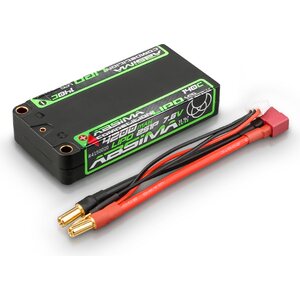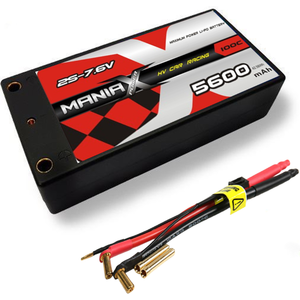When starting out a new racing class you always run into the same old question;
which battery should I go for?
For us who drive 1/10th scale off-road classes the task of picking a battery has been made a little easier over the last few years since we really only have to worry about the weight, weight distribution and capacity of the battery. Buggies, stadium trucks and short course trucks all really only use 2S shorty batteries these days. Don't get it twisted, though, it's still very important to look at all the options you've got since the term shorty only defines two values of dimensional measurements.Batteries with different capacities are usually different in terms of weight and height, and these can play an important role in the handling of a racecar. The capacity alone is a big question and to find the answer to that question you need to factor in the
class and the
track surface.
Pictured here is a 2WD buggy by Team Associated with a shory battery held in position with a JConcepts battery hold down.
2WD BuggiesIn the 2WD buggy classes people use all kinds of batteries, because in different circumstances diferent features may come in handy. When driving on high traction surfaces it'd be great to have a battery with a little bit of extra capacity. However, the competition is so close that sometimes racers have to go for he best handling they can get regardless of the run time. On very high bite tracks like EOS-style carpet tracks many drivers go for smaller 3800-4100mAh batteries despite the limited run time to be aable to lower the center of gravity of the car by running a thinner battery and sometimes ven putting thin brass weights underneath it. Whichever way they go about it the reult is generally that the center of gravity of the car sits lower than it would with a taller 6000mAh battery.
On the other hand in stock classes around the world this can be flipped on its head at times. Some drivers choose to sacrifice handling charasteristics to make the most of the less powerful motor through the whole heat. Bigger batteries have also more capacity to lose over time before the battery is unusable. Given that for most 2WD buggy configurations 4000mAh is enough for a 5 minute heat you could technically finish a race with a 6000mAh batterythat has lost a third of its capacity. Of course this isn't exactly how it goes as a battery in that state is probably already in its final resting place.
Here in Finland we mostly run on low grip concrete tracks which is why our 2WD buggies don't really have too much power generally. This is a big part of the reason why smaller batteries are popular around here. Very thin 3600-4100mAh batteries and the so called mid-sized 4200-4800mAh batteries are the most popular option for most track surfaces in this class here. On bumpier tracks taller batteries can be a good thing as they rase the center of gravity of the car which allows the car to roll more which often increases overall grip up until a certain point. On flat surfaces having a car stay flat can often improve grip si thinner batteries are often the way to go. Given that they also lower the chances of traction rolling it's no wonder they're usually the go-to option for any flat surfaces. On high traction tracks it can be a little risky to opt for a battery with under 4000mAh of capacity since cars set up for more power also need more battery life. With a battery that has less caapcity than that racers may not always be able to run warm-up laps before their heat which can e less than ideal at times.
Here are the most popular battery options for 2WD buggies here in Finland:
4WD Buggies4WD buggies are usually set up for more power than their 2WD counterparts. More power drains more capacity to achieve the same run time as a car with less power and capacity. This is why the average racer often goes for a mid-sized 4200-4800mAh battery if not a bigger one. However some of the competitors especially at the very top still go for smaller batteries. There's a few reasons for this. Especially in high traction conditions having a lower center of gravity may be crucial with 4WD buggies to avoid traction rolls when attacking corners at high speeds. It's important to remember here that sometimes a taller battery may also lead to higher corner speeds as the car rolls more. Another reason why a driver may want a smaller battery for their ¤WD buggy is that most modern 4WD buggies hae the battery located in the rear of the car so a smaller battery will move the center of gravity forward which can improve handling in certain conditions. A thinner battery can also be used to move the weight back since it allows for more weights under the battery.
Most 4WD buggy racers pick the mid-sized batteries for most surfaces. High powered 4WD buggies that often use 5.5T motors on higher traction surfaces can drain the life out of a battery much quicker than a 2WD buggy would which is why it can save you money to run a bit bigger battery than the top guys since you wont need a new one quite as often. The tallest of the bateries in the other hand raise the center of gravity quite a lot so we'd only recommend those if you really need to allow the car to roll as much as possible.
Here are the most popular battery options for 4WD buggies in Finland:
Truck-classesThe heaviest 1/10th scale racecars can be found in thee classes. Stadium trucks, truggies and short courses are generally not the lightest things in the world. Heavy cars require a lot of power so it's no wonder that heavier tall 5000-6300mAh batteries are usually the battery of choice in these classes. In some cases drivers still opt for the mid-sized batteries but generally all the drivers from the ones starting ot to world champions run the biggest battery they can get their hands on because of the weight, weight distribution and shifting of the weight. For example the center of gravity of a stadium truck is really low in comparison to the width of the car so a taller battery often improves traction by allowing the main chassis to roll more. The only real exception to the rule of taller batteries in these lasses are the 2WD short course trucks that often use mid-sized batteries with weights undeneath them. The center of gravity of these trucks is usually very high up and bringing it lower wont do harm.
Here are the most popular battery options for truck classes here in Finland:
ConclusionSo the options for batteries are a pretty wide variety even in the world of 2S shorties. Different batteries help you achieve different things, so there's really no one true answer for a battery in any of the classes. As with everything that changes the handling of the car testing is the only way to truly find out which battery is the best option for you and your car. Asking around your local track if you could try out some batteries would be a great idea and if you don't like borrowing stuff you can also ask people who have tried out multiple options which one the prefer for their application. It's important to note here that their car may be set up differently than yours, though. This can have an effect on which battery you should use.
Below you'll find all of the racing 2S shorties we have available:
You might also be interested in
EnjoyRC.fi on nyt auki – RC-harrastajien uusi kotipesä verkossa!
EnjoyRC.fi on nyt auki – RC-harrastajien uusi kotipesä verkossa!
RC-autoilun ystäville on hyviä uutisia: uusi verkkosivusto EnjoyRC.fi on avautunut! Sivusto tarjoaa entistä sujuvamman ja käyttäjäystävällisemmän tavan hoitaa RC-harrastukseen liittyviä asioita.
Älykäs cha...
Ajanottosysteemi kotiradalle – Lapmonitor nyt saatavilla!
Kotipihojen rallikuskit, nyt on tilaisuus viedä ajoharjoittelu uudelle tasolle! Tarkka ajanotto on olennainen osa kilpa-ajon kehittämistä, ja nyt voit saada ammattitason Lapmonitor-ajanottolaitteen edulliseen hintaan kotiradallesi.
Olitpa sitten järjestämässä leikkimielisiä...
Vinkkejä betonille
Krossiradan pinta on vaihtunut taas betoniksi, ja on aika laittaa autojen säädöt uuteen uskoon. Alta löytyy muutamia kikkoja, joista saattaisi olla apua uusia säätöjä miettiessä.
Maltilliset tehot:
Kovapitoisiin alustoihin verrattuna kaasun käyttö on betonialus...
 +
+
 +
+
 +
+
 +
+
 +
+
 +
+
 +
+